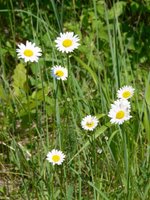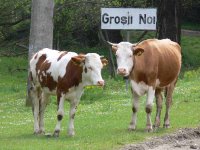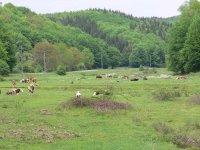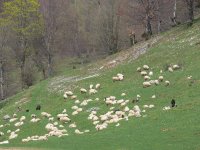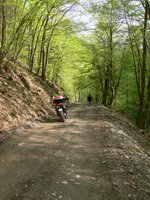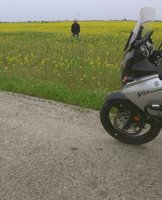Our riding loop into the Semenic Mountains was much more of an adventure than we thought when we set out early in the afternoon! The ride to Timisoara, 46 km away was quick and eventless. We rode through the city and on to Recas—a town known for its vineyards and good wines. For those of you snickering behind your monitors (you know who you are), Romania does produce some good wines… he he he. The town is situated among gently sloping hills, and produces the domestic Feteasca Regala and Muscat Ottonel, along with a good selection of Riesling, Pinot Grigio, Sauvignon Blanc, and Chardonnay.

Next, we headed down the road into Lugoj for a quick stretch in the picturesque downtown. Lugoj is home to a good number of Romanian musicians and composers. Lugoj is also the birthplace of Bela Lugosi (born 1882 as Bela Ferenc Blasko), the actor who immortalized the original Dracula character in the famous Hollywood film.
 From Lugoj we continued our journey to Caransebes. Outside of Caransebes, towards Resita, we were greeted by the smoothest stretch of road we have encountered yet, with expansive mountain views and orchards lining both sides of the highway. The roads were reminiscent of our riding days in Eastern Kentucky and those great twisty roads! For a brief period all of the V-Strom’s 98 horses were allowed to roam freely—what joy!
From Lugoj we continued our journey to Caransebes. Outside of Caransebes, towards Resita, we were greeted by the smoothest stretch of road we have encountered yet, with expansive mountain views and orchards lining both sides of the highway. The roads were reminiscent of our riding days in Eastern Kentucky and those great twisty roads! For a brief period all of the V-Strom’s 98 horses were allowed to roam freely—what joy!Entering the city of Resita we were greeted by what was once one of Romania’s preeminent industrial cities—an important steel center during the communist heydays. Much of the town’s landscape is marred by steel mills, factories and conveyor belts, most of them left in disarray and abandon.

We quickly passed through town and headed up into the mountains towards Semenic, a well-known ski resort during the winter months. The ascent was beautiful, as it was in the late afternoon and the sun was highlighting all of the valleys and villages nestled in the mountains. The road is narrow and winds upward, mile after mile, at times, displaying significant potholes. It’s a real challenge, particularly when you meet an oncoming logging truck. After what seemed like miles, we came upon the quiet mountain village of Valiug.
 Did we fail to mention that we had not taken water or food with us? Yes, this journey was only supposed to be a quick afternoon loop! (As we have learned when riding and exploring, time becomes irrelevant for our driver…) However, the forest (padurea) provided us with a special treat – a natural spring bursting straight out of the mountainside!
Did we fail to mention that we had not taken water or food with us? Yes, this journey was only supposed to be a quick afternoon loop! (As we have learned when riding and exploring, time becomes irrelevant for our driver…) However, the forest (padurea) provided us with a special treat – a natural spring bursting straight out of the mountainside!
From the water stop, we headed to the Semenic Ski Resort. There was still snow on the sides of the road and a strong wind blew across the mountain, which explained the wind mills perched up top. We passed a shack serving as the resort store, bar and coffee house. The expressions on the people’s faces as we rode by clearly indicated that we were either crazy or from outer space to be riding a bike up there. Even the watch dogs lounging outside glanced up but didn’t budge as we passed.
Of course, to add spice to the trip, our gas gauge dropped precipitously to one bar—a bit suddenly and unexpectedly. Here we were on top of the mountain and the closest gas station was somewhere in the valleys below, a good distance away. And we intended to descend on the eastern slope of the mountain, in the opposite direction from Resita.
 As we rode into the town of Brebu Nou, we stopped to ask a kind lady if we were headed in the right direction. She confirmed that the road was the right one, but mentioned that the condition of the road was “really bad up ahead.” Then, looking at and visibly measuring the bike with her glance, she continued, “but with that, it’s gonna work.”
As we rode into the town of Brebu Nou, we stopped to ask a kind lady if we were headed in the right direction. She confirmed that the road was the right one, but mentioned that the condition of the road was “really bad up ahead.” Then, looking at and visibly measuring the bike with her glance, she continued, “but with that, it’s gonna work.”Encouraged, we rode on, and for a while didn’t experience anything too bad, except for the fact that the pavement gave way to cobblestone. OK, we can handle this… But then, sure enough, the cobblestone disappeared and gave way to dirt with deep potholes, mud in spots and sharp turns!
With the sun slowly setting and the gas light flashing, we decided that we might run out of gas at
 this rate. So, the motor was shut off, the headlights left on, and we descended for 10 miles with nothing but the sound of the tires crushing stone and the rush of air around us. What an eerie experience! An almost 500-pound bicycle rolling down the hill at 15-25 miles per hour…thank God for shocks and springs. These miles seemed like hours, as we painstakingly navigated potholes and mud, often standing on the foot pegs. We only had to start the engine once in all those miles for a few seconds, because the slope had leveled off briefly. My wife remembered that the camera was still around her neck and decided to film a portion of this experience to share with you all—unfortunately, we managed to erase it!
this rate. So, the motor was shut off, the headlights left on, and we descended for 10 miles with nothing but the sound of the tires crushing stone and the rush of air around us. What an eerie experience! An almost 500-pound bicycle rolling down the hill at 15-25 miles per hour…thank God for shocks and springs. These miles seemed like hours, as we painstakingly navigated potholes and mud, often standing on the foot pegs. We only had to start the engine once in all those miles for a few seconds, because the slope had leveled off briefly. My wife remembered that the camera was still around her neck and decided to film a portion of this experience to share with you all—unfortunately, we managed to erase it!A truly funny moment that sent us both into laughter was when we met a man walking uphill on this stretch of forest road. We greeted him with a simple “Buna” (short form for Good Day), and he simply stopped and stared with mouth agap as the motorcycle quietly rolled-by. His expression was clearly puzzled—what the heck are these two riding?
We finally coasted into the sleepy town of Slatina de Timis, and passed old homes and children playing in the street. In the center of town we restarted the engine. Not only was the gaslight no longer blinking, but there were TWO bars indicating plenty of gas! Now it was our time to be puzzled and wonder ‘what the heck?!’
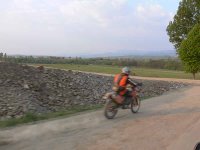 As we drove through town looking for a gas station, four dirt bikes with their riders covered in mud from top to bottom blew right by us raising a cloud of dust. These folks clearly knew the best mode of transportation to explore this region—a real off-road bike!
As we drove through town looking for a gas station, four dirt bikes with their riders covered in mud from top to bottom blew right by us raising a cloud of dust. These folks clearly knew the best mode of transportation to explore this region—a real off-road bike!As the sun was setting, we left the mountains and drove 20 kilometers to Caransebes for gas (and a bathroom)! As we gassed-up for the 2-hour ride back, we realized what an unexpected, yet fantastic trip the day had offered. – BGR & HSR














